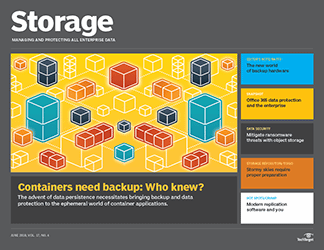PRO+ Premium Content/Storage
Access your Pro+ Content below.
Office 365 data protection, the enterprise and you

This article is part of the Storage issue of June 2018, Vol. 17, No. 4
Office 365 has grown in popularity since Microsoft first made the cloud-based productivity, communication and collaboration suite generally available in June 2011. So much so, Microsoft said it now supports over 120 million active Office 365 users in commercial environments. That means developing and enforcing an Office 365 data protection strategy must be high on IT professionals' to-do lists as they deal with exponential growth in Office 365 deployments. A March 2018 Osterman Research white paper, "Supplementing the Limitations in Office 365" corroborates Microsoft's success with Office 365. Osterman's surveys showed that Office 365 penetration among corporate users at midsize to large organizations has grown steadily year to year from 5% in 2014 to more than 60% this past January. That's a 1,200% increase in Office 365 use over four years. Furthermore, the firm predicted Office 365 corporate penetration will hover close to 80% by January 2019. In its white paper, Osterman Research noted that Office 365 does a lot well, but ...
Features in this issue
-
Container backup follows data persistence to these ephemeral apps
The advent of data persistence in containers necessitates having data backup in containers. Here's how this is being done and which vendors are leading the way.
-
Office 365 data protection, the enterprise and you
Gain a better understanding of Microsoft Office 365 security and storage management features and how the popular cloud-based productivity and collaboration suite really works.
Columns in this issue
-
What's new with data protection systems? Everything
The next backup hardware you purchase will likely come with integrated backup software. That changes the buying dynamic and complicates the decision-making process.
-
Disaster avoidance requirements ensure business continuity
Include disaster recovery and avoidance requirements as design goals when creating storage and production environments to ensure business continuity during weather events.
